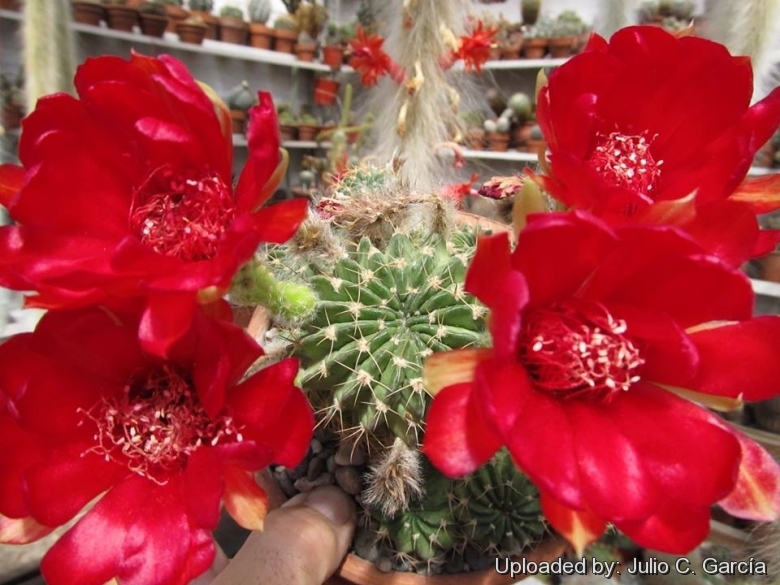Donate now to support the LLIFLE projects.
Your support is critical to our success.
Your support is critical to our success.
Accepted Scientific Name: Echinopsis ancistrophora subs. pojoensis (Rausch) Rausch
Lobivia 3: 140. 1976

Lobivia calorubra var. pojoensis (Echinopsis ancistrophora subs. pojoensis) Photo by: Julio C. García
Synonyms:
- Echinopsis ancistrophora subs. pojoensis (Rausch) Rausch
- Lobivia calorubra var. pojoensis (Rausch) Rausch
- Lobivia pojoensis Rausch
See all synonyms of Echinopsis ancistrophora
back
Accepted name in llifle Database:Echinopsis ancistrophora Speg.
Anales Mus. Nac. Buenos Aires ser. 3, 4: 492. 1905
Synonymy: 31
- Echinopsis ancistrophora Speg.
- Cereus pasacanus (F.A.C.Weber ex Rümpler) F.A.C.Weber
- Mesechinopsis ancistrophora (Speg.) Y.Itô
- Pseudolobivia ancistrophora (Speg.) Backeb. ex Krainz
- Echinopsis ancistrophora var. hamatacantha (Backeb.) Rausch
- Echinopsis hamatacantha Backeb.
- Mesechinopsis hamatacantha (Backeb.) Y.Itô
- Pseudolobivia hamatacantha (Backeb.) Backeb.
- Echinopsis ancistrophora var. megalocephala (Rausch) Rausch
- Echinopsis rauschii var. megalocephala Rausch
- Lobivia calorubra var. megalocephala (Rausch) Rausch
- Echinopsis ancistrophora var. polyancistra (Backeb.) Rausch
- Echinopsis polyancistra Backeb.
- Mesechinopsis polyancistra (Backeb.) Y.Itô
- Pseudolobivia polyancistra (Backeb.) Backeb.
- Echinopsis ancistrophora var. rubriflora Rausch
- Echinopsis leucorhodantha Backeb.
- Mesechinopsis leucorhodantha (Backeb.) Y.Itô
- Pseudolobivia leucorhodantha (Backeb.) Backeb. ex Krainz
- Echinopsis lobivioides Backeb.
- Echinopsis pelecyrhachis var. lobivioides (Backeb.) H.Friedrich
- Lobivia grandiflora var. lobivioides (Backeb.) Rausch
- Mesechinopsis lobivioides (Backeb.) Y.Itô
- Pseudolobivia lobivioides Backeb. ex Krainz
- Pseudolobivia pelecyrhachis var. lobivioides (Backeb.) Backeb.
- Echinopsis pelecyrhachis Backeb.
- Mesechinopsis pelecyrhachis (Backeb.) Y.Itô
- Pseudolobivia pelecyrhachis Backeb. ex Krainz
- Echinopsis subdenudata Cárdenas
- Echinopsis subdenudata f. cristata aurea hort.
- Echinopsis subdenudata f. cristata hort.
Echinopsis ancistrophora subs. arachnacantha (Buining & F.Ritter) Rausch
Lobivia 3: 140. 1977
Synonymy: 22
- Echinopsis ancistrophora subs. arachnacantha (Buining & F.Ritter) Rausch
- Echinopsis arachnacantha (Buining & F.Ritter) H.Friedrich
- Lobivia arachnacantha Buining & F.Ritter
- Echinopsis ancistrophora var. densiseta (Rausch) Rausch
- Echinopsis arachnacantha subs. densiseta (Rausch) M.Lowry
- Echinopsis arachnacantha var. densiseta (Rausch) Friedrich
- Lobivia arachnacantha var. densiseta Rausch
- Echinopsis ancistrophora var. kratochviliana (Backeb.) Rausch
- Echinopsis kratochviliana Backeb.
- Neolobivia kratochviliana (Backeb.) Y.Itô
- Pseudolobivia kratochviliana Backeb.
- Echinopsis ancistrophora var. sulphurea (R.Vásquez) Rausch
- Echinopsis arachnacantha subs. sulphurea (R.Vásquez) Lowry
- Echinopsis arachnacantha var. sulphurea (R.Vásquez) G.D.Rowley
- Lobivia arachnacantha var. sulphurea R.Vásquez
- Echinopsis ancistrophora var. torrecillasensis (Cárdenas) Rausch
- Echinopsis arachnacantha subs. torrecillasensis (Cárdenas) M.Lowry
- Echinopsis arachnacantha var. torrecillasensis (Cárdenas) Friedrich
- Echinopsis torrecillasensis Cárdenas
- Lobivia arachnacantha var. torrecillacensis (Cárdenas) Buining
- Pseudolobivia torrecillasensis (Cárdenas) Backeb.
- Echinopsis arachnacantha var. vallegrandensis Rausch
Echinopsis ancistrophora subs. cardenasiana (Rausch) Rausch
Lobivia 3: 140. 1977
Synonymy: 3
- Echinopsis ancistrophora subs. cardenasiana (Rausch) Rausch
- Echinopsis cardenasiana (Rausch) Friedrich
- Lobivia cardenasiana Rausch
Echinopsis ancistrophora subs. pojoensis (Rausch) Rausch
Lobivia 3: 140. 1976
Synonymy: 6
- Echinopsis ancistrophora subs. pojoensis (Rausch) Rausch
- Lobivia calorubra var. pojoensis (Rausch) Rausch
- Lobivia pojoensis Rausch
- Echinopsis ancistrophora var. grandiflora (Rausch) Rausch
- Echinopsis rauschii var. grandiflora (Rausch) H.Friedrich
- Lobivia pojoensis var. grandiflora Rausch
back
| Your Actions | |
|---|---|
| Back to Lobivia index | |
| Back to Cactaceae index | |
 |
Back to Cacti Encyclopedia index |









